
Clam is a common name for several kinds of bivalve molluscs. The word is often applied only to those that are edible and live as infauna, spending most of their lives halfway buried in the sand of the seafloor or riverbeds. Clams have two shells of equal size connected by two adductor muscles and have a powerful burrowing foot. They live in both freshwater and marine environments; in salt water they prefer to burrow down into the mud and the turbidity of the water required varies with species and location; the greatest diversity of these is in North America.

Bivalvia, in previous centuries referred to as the Lamellibranchiata and Pelecypoda, is a class of marine and freshwater molluscs that have laterally compressed bodies enclosed by a shell consisting of two hinged parts. As a group, bivalves have no head and they lack some usual molluscan organs, like the radula and the odontophore. The class includes the clams, oysters, cockles, mussels, scallops, and numerous other families that live in saltwater, as well as a number of families that live in freshwater. The majority are filter feeders. The gills have evolved into ctenidia, specialised organs for feeding and breathing. Most bivalves bury themselves in sediment, where they are relatively safe from predation. Others lie on the sea floor or attach themselves to rocks or other hard surfaces. Some bivalves, such as the scallops and file shells, can swim. Shipworms bore into wood, clay, or stone and live inside these substances.

The Arcida is an extant order of bivalve molluscs. This order dates back to the lower Ordovician period. They are distinguished from related groups, such as the mussels, by having a straight hinge to the shells, and the adductor muscles being of equal size. The duplivincular ligament, taxodont dentition, and a shell microstructure consisting of the outer crossed lamellar and inner complex crossed lamellar layers are defining characters of this order.

The maxima clam, also known as the small giant clam, is a species of bivalve mollusc found throughout the Indo-Pacific region.

Barbatia is a genus of "bearded" ark clams, marine bivalve mollusks in the family Arcidae, the ark clams.

Anadara is a genus of saltwater bivalves, ark clams, in the family Arcidae. It is also called Scapharca.

Glycymerididae, often misspelled as Glycymeridae, common names dog cockles or bittersweets, is a worldwide family of salt water clams, marine bivalve mollusks in the order Arcida. They are related to the ark clams. This family contains 45 extant species in four genera.

Placunidae, also known as windowpane oysters, windowpane shells, and Capiz shells, are a taxonomic family of saltwater clams, marine bivalve mollusks which are related to oysters and scallops.

The Semelidae are a family of saltwater clams, marine bivalve molluscs in the order Cardiida.

A bivalve shell is part of the body, the exoskeleton or shell, of a bivalve mollusk. In life, the shell of this class of mollusks is composed of two hinged parts or valves. Bivalves are very common in essentially all aquatic locales, including saltwater, brackish water, and freshwater. The shells of bivalves commonly wash up on beaches and along the edges of lakes, rivers, and streams. Bivalves by definition possess two shells or valves, a "right valve" and a "left valve", that are joined by a ligament. The two valves usually articulate with one another using structures known as "teeth" which are situated along the hinge line. In many bivalve shells, the two valves are symmetrical along the hinge line—when truly symmetrical, such an animal is said to be equivalved; if the valves vary from each other in size or shape, inequivalved. If symmetrical front-to-back, the valves are said to be equilateral, and are otherwise considered inequilateral.
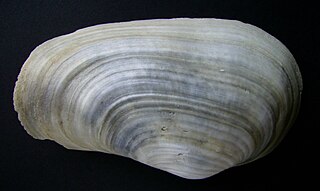
Panopea is a genus of large marine bivalve molluscs or clams in the family Hiatellidae. There are 10 described species in Panopea. Many of them are known under the common name "geoduck".
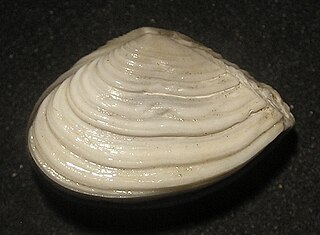
Corbula is a genus of very small saltwater clams, marine bivalve molluscs in the family Corbulidae, the basket clams.

Arca is a genus of saltwater clams in the family Arcidae, the ark clams.
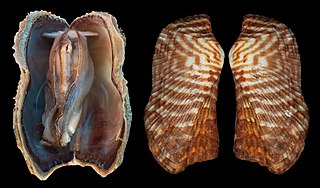
Arca zebra, or the turkey wing ark clam, is a bivalve mollusc in the family Arcidae, the ark clams.
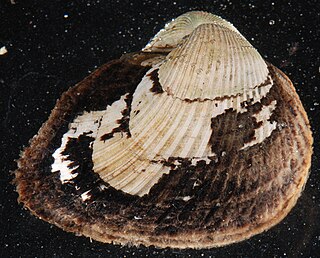
Noetia ponderosa, or the ponderous ark clam, is a marine clam in the family Noetiidae.

Hinge teeth are part of the anatomical structure of the inner surface of a bivalve shell, i.e. the shell of a bivalve mollusk. Bivalves by definition have two valves, which are joined together by a strong and flexible ligament situated on the hinge line at the dorsal edge of the shell. In life, the shell needs to be able to open slightly to allow the foot and siphons to protrude, and then close again, without the valves moving out of alignment with one another. To make this possible, in most cases the two valves are articulated using an arrangement of structures known as hinge teeth. Like the ligament, the hinge teeth are also situated along the hinge line of the shell, in most cases.

Tucetona is a genus of saltwater clams, marine bivalve molluscs in the family Glycymerididae, the bittersweet clams. Unlike other genera in the family, Tucetona species have a ribbed shell.

Acar is a genus of small saltwater clams, marine bivalve mollusks in the family Arcidae, the ark clams.
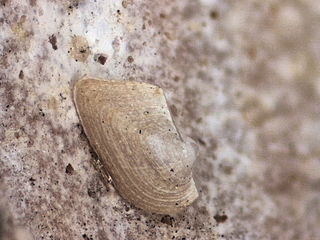
Striarca is a genus of bivalves belonging to the family Noetiidae.

Glycymeris longior is a species of living marine clam of the genus Glycymeris. It was common in the Quaternary on the Atlantic coast of South America. The shells of this species is frequently found on beaches from Patagonia to Brazil.




















